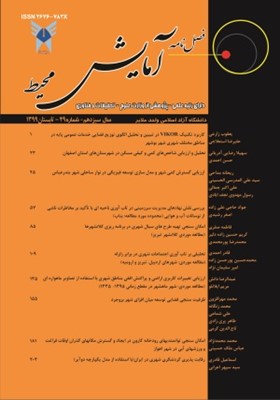تحلیلی بر تاب آوری اجتماعات شهری در برابر زلزله (مطالعه موردی: شهرهای اردبیل، تبریز و ارومیه)
محورهای موضوعی : آمایش محیط
قادر احمدی
1
*
,
محمدحسین پورحسن زاده
2
![]() ,
امیر سلیمان نژاد
3
,
امیر سلیمان نژاد
3
1 - استادیار گروه شهرسازی، دانشگاه ارومیه، ارومیه، ایران
2 - دانشجوی کارشناسی ارشد برنامهریزی شهری، دانشگاه ارومیه، ارومیه، ایران
3 - دانشجوی کارشناسی ارشد برنامهریزی شهری، دانشگاه ارومیه، ارومیه، ایران
کلید واژه: تبریز, اردبیل, ارومیه, تاب آوری, سوانح طبیعی, تاب آوری اجتماعات شهری,
چکیده مقاله :
زلزله از جمله سوانح طبیعی است که بیشتر شهرهای جهان با آن مواجه هستند. این مسئله عموماً با گستردهترین دخالتهای نسنجیده انسانی در محیط طبیعی از جمله ساخت و سازهای بی رویه در حریم گسل، فقدان و یا بی توجهی به ضوابط و استانداردهای ساخت و ساز تشدید میشود. در این میان افزایش تاب آوری شهرها در برابر بلایای طبیعی به ویژه زمین لرزهها به میزان زیادی در کاهش این خسارات و همچنین زمان بهبودی جوامع مؤثر است. بر این اساس، پژوهش حاضر به دنبال ارزیابی و مقایسه تاب آوری شهرهای اردبیل، تبریز و ارومیه در چهار بعد اجتماعی، اقتصادی، نهادی-مدیریتی و کالبدی-محیطی است. روش تحقیق این پژوهش توصیفی - تحلیلی و ماهیت آن کاربردی میباشد. در این پژوهش، ابتدا چارچوب نظری تحقیق از طریق جمع آوری اطلاعات با استفاده از مطالعات اسنادی صورت پذیرفت. در ادامه به منظور بررسی میزان تاب آوری شهرهای مورد مطالعه با بررسی پژوهشهای قبلی، معیارها و زیرمعیارهای تاب آوری تعیین گردید. سپس مقادیر هر یک از شاخصها با بررسیهای میدانی، طرحهای مصوب و... در هر یک از نواحی مورد مطالعه بدست آمده است و به منظور تجزیه و تحلیل دادهها از روشهای آمار توصیفی نظیر میانه، میانگین، انحراف معیار، نمودارها و آمار استنباطی (آزمونOne sample T-test ) در نرم افزار Spss استفاده شده است. نتایج نشان میدهد شهرهای اردبیل و تبریز به ترتیب با میانگین امتیاز 15/3 و 33/3 (بالاتر از حد متوسط 3) در وضعیت مطلوبی از نظر تاب آوری قرار دارند. اما شهر ارومیه با میانگین تاب آوری 71/2 (پایینتر از حد متوسط 3) در وضعیت نامناسبی در مقابل بحرانها قرار دارد.
The earthquake is one of the natural disasters with which the majority of cities in all countries encountered. This issue has been generally reinforced by the widest unconsidered human intervention in natural environment like unconventional constructions in the earthquake fault range, lack or neglecting of criteria and constructions standards. Increasing the resilience of cities to natural disasters specifically earthquake is greatly effective in reducing damages and also is effective for recovery periods of communities. Accordingly, the present study seeks to evaluate and compare the resilience of Ardebil, Tabriz, and Urmia cities in four social, economic, institutional and physical-environmental dimensions. The research method is descriptive - analytic and its nature is an applied one. In this research, the theoretical framework of the research was initially carried out through the collection of information and the use of documentary studies. In order to investigate the resilience of the understudied cities, resilience criteria and sub-criteria were determined by examining the previous studies. Then the values of each of the indicators were obtained by field studies and approved projects in each of the understudied areas and the obtained data were analyzed using SPSS software. The results showed that the cities of Ardebil and Tabriz were in a favorable situation with an average score of 3.35 and 3.33 respectively (higher than the average of 3), but the city of Urmia with an average of 2.71 (below the average of 3) was in an unsatisfactory situation in case of crises.
19. Davis, I. & Izadkhah, Y.2006. Building Resilient Urban Communities. Article from OHI, 31, 1, 11-21.
20. Desouza, Kevin C, H. & Flanery, Trevor.2013. Designing, planning, and managing resilient cities: A conceptual framework, Cities 35, pp. 89–99.
21. Klein, R. J. N. and Thomalla, F.2003. Resilience to Natural Hazards: How Useful is this Concept, Environmental Hazards, Vol. 5, No. 1–2, PP. 35–45.
22. Normandin, J._M, Therrien M._C, Tanguay G.A.2011. City strength in times of turbulence: strategic resilience indicators, Urban Affairs Association 41 st Conference, new Orleans.
23. Norris, Fran H & Stevens, Susan P.2007. Community Resilience as a Metaphor, Theory, Set of Capacities, and Strategy for Disaster Readiness, Springer Science.
_||_

